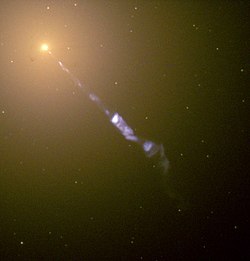Synchrotron radiation/Problem set
This problem set is aimed at synchrotron radiation.

The functional form should be sufficient to use so that synchrotron radiation is as easy to compare to spectra as is Planck's equation for blackbody radiation.
Synchrotron radiation
edit"Synchrotron radiation is the electromagnetic radiation emitted when charged particles travel in curved paths. Because in most accelerators the particle trajectories are bent by magnetic fields, synchrotron radiation is also called Magneto-Bremsstrahlung. The emitted spectrum is broadband from the microwave (harmonics of the driving RF field) to x-ray spectral regions. The radiation is vertically collimated and polarized. The synchrotron radiation output can be calculated if the electron energy, bending radius, electron current, angle relative to the orbital plane, the distance to the tangent point and vertical and horizontal acceptance angles are known."[1]
Problem 1
editUsing the derivative of Planck's equation, calculate the wavelength, temperature pair for 6000 K.
The reference "Uwe" in the list near the resource page bottom calculates synchrotron radiation spectra using the electron energy (MV), the bending radius (m), the angle relative to the orbital plane (Psi/mrad), a bandwidth (%), the electron beam current (mA), starting wavelength (nm), and ending wavelength (nm) for 256 points.
Vary the electron energy at "Calculate the Synchrotron Radiation Spectrum" to get the synchrotron peak to match the (wavelength, temperature) pair.
When you have a matching synchrotron spectrum, vary the magnetic field bending radius from just above 0.0 to 2.0 and record the changes in the peak wavelength and intensity.
Problem 2
editCalculate the area under the curve for the Planck spectrum with the peak at the (wavelength, temperature) pair.
For your synchrotron spectrum with its matching (wavelength, electron energy) pair, convert the electron energy to temperature to see if they match.
Adjust the electron energy until the temperatures match.
Calculate the area under the curve and compare with the area from the Planck spectrum.
If the areas do not match, adjust the bending radius to optimize the area under the curve so that only a simple scale factor if any is needed.
If a scale factor is needed, increase or decrease the electron current.
Problem 3
editFor an electron energy of 700.0 MeV, adjust the bending radius until the peak in total nW again matches the (wavelength, temperature) pair.
If the bending radius is inversely proportional to the magnetic field, how much stronger does the magnetic field have to be?
Problem 4
editUsing the electron energy that matches the temperature, adjust the bending radius until the nW peak is again at the correct wavelength.
Problem 5
editWhen the angle relative to the orbital plane is increased in small units from zero, what changes to the bending radius must be performed to keep the peak at the same wavelength?
Document some examples.
See also
edit- Angular momentum and energy
- Column densities
- Cosmic circuits
- Energy phantoms
- Furlongs per fortnight
- Planck's equation
- Radiation astronomy/Problem set
- Radiation dosage
- Radiation astromathematics problems
- Spectrographs
- Star jumping
- Telescopes and cameras
- Unknown coordinate systems
- Unusual units
- Vectors and coordinates
References
edit- ↑ Uwe Arp (June 2003). Synchrotron Radiation. Gaithersburg, Maryland USA: National Institute of Standards and Technology NIST). http://physics.nist.gov/MajResFac/SURF/SURF/sr.html. Retrieved 2014-04-02.
External links
edit- International Astronomical Union
- NASA/IPAC Extragalactic Database - NED
- NASA's National Space Science Data Center
- NCBI Site Search
- Office of Scientific & Technical Information
- The SAO/NASA Astrophysics Data System
- Scirus for scientific information only advanced search
- SDSS Quick Look tool: SkyServer
- Spacecraft Query at NASA
- Universal coordinate converter
{{Geology resources}}{{Materials science resources}}{{Mathematics resources}}